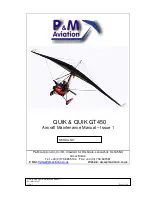
R
EMOS
3
600
73
73
R
EMOS
3
600
Supplementary Information
10.1
Flight training supplement
10.1.9
Approach
10
Approach in crosswind conditions
Cross-winds will not have a big effect to the flight characteristics or the G-3 /600 as long
as wind speed stays within the maximum permissible speed up to 17 mph (15 kts).
Conducting a cross-wind landing does will not require special skills, nevertheless, if not
yet familiar with the aircraft, we recommend to initially exercise crosswind landings only
when accompanied by an experienced flight instructor until sufficient experience has
been gained.
Approach in turbulent weather conditions
If turbulences are indicated or wind shifts are expected, we recommend to establish an
airspeed of 65 mph (56 kts). This will give you a reserve airspeed to balance any
unexpected deviations in altitude and heading. In more gusty conditions it may beneficial
to stabilize the glide slope by keeping the flap setting to the 15° position. Increasing
airspeed above 65 mph (56 kts) will not be helpful to stabilize the aircraft, so this should
be avoided.
Approach in rain showers
Raindrops on the wing surfaces influence the aerodynamic characteristics of the airfoil,
drag will increase while lift decreases. The REMOS G-3 airfoil used on the REMOS G-3
/600 features stable flight characteristics in rain conditions. So there are no special
advisories for flights within rain, we recommend to operate the aircraft like in turbulent
weather conditions (see "Approach at turbulent weather conditions).















































